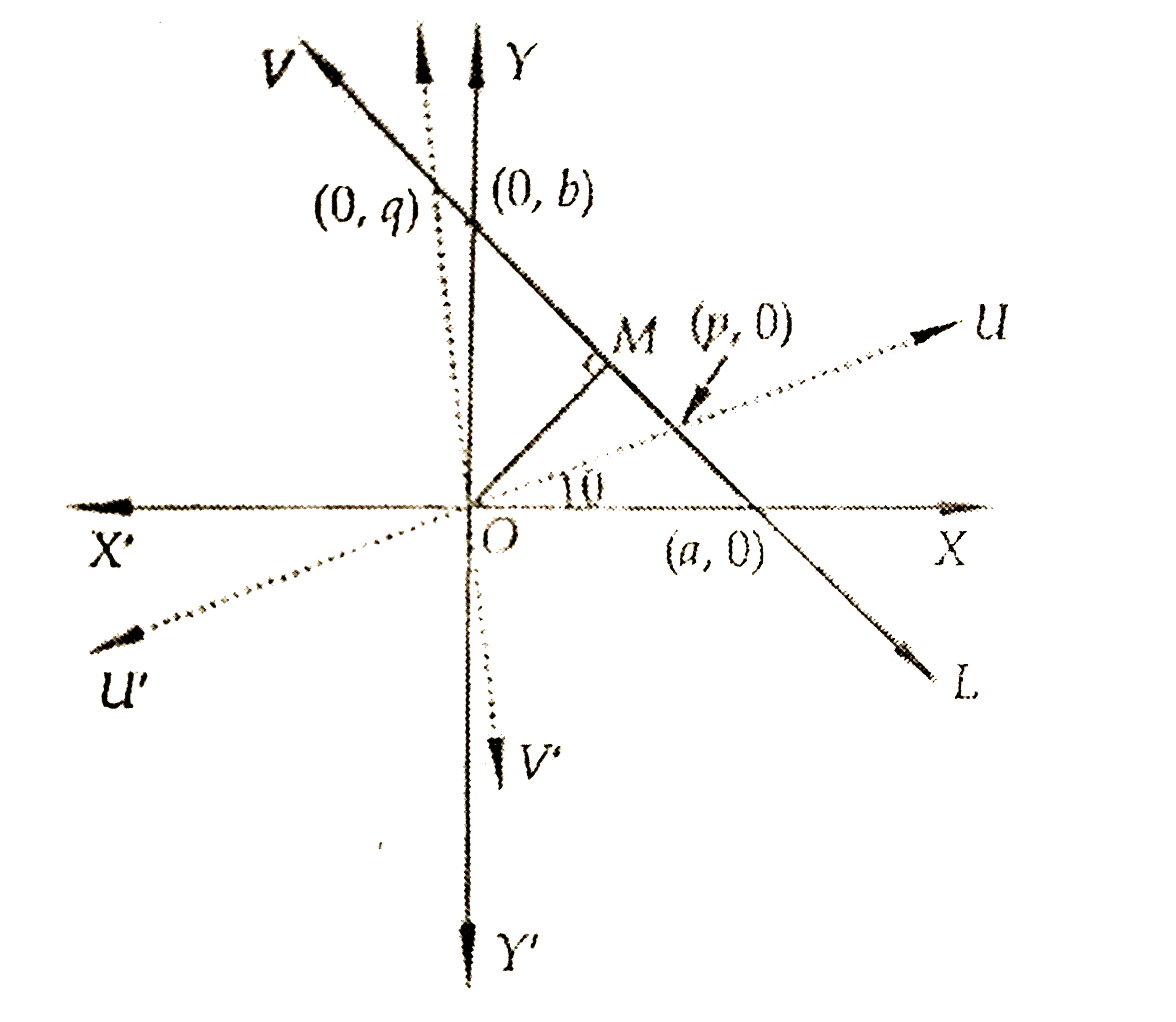Thu Line L has intercept a and b on the co-ordinate axes. When keeping the origin fixed, the coordinate axis are rotated around a fixed angle, then the line has intercepts p and q on rotate axis, then
a2+b2=p2+q2
1a2+1b2=1p2+1q2
a2+p2=b2+q2
1a2+1p2=1b2+1q2
The correct Answer is:B
The equation of line L with reference to the old axis is
xa+yb=
OM=Length of the perpendicular from O(0,0) on it
⇒OM=1√1a2+1b2 …(i)
Let the axes be rotated through an angle θ . With reference to the new axes, the equation of the line L is
xp+yq=1
∴ OM =Length of hte perpendicular from O(0,0) on it
⇒Om=1√1p2+1q2 ...(ii)

From (i) and (ii), we get
2√1a2+1b2=1√1p2+1q2⇒1a2+1b2=1p2+1q2
This is the required relation .
ALITER The equation of the line with reference to the old axes is xa+yb=1 ...(i)
If the axes are rotated through an angle θ, then
x=Xcosθ−Ysinθ,y=Xsinθ+Ycosθ
here X and Y coordinates of a point P(x,y) with respect to new-axes
The equation of the line with respect to new axes is
Xp+Yq=1 (ii)
Substituting the values of x and y in (i) , we get
(cosθa+sinθb)X+(−sinθa+cosθb)Y=1 ...(iii)
Clearly, (ii) and (iii) represent the same line . Therefore,
1p=cosθa+sinθband,1q=−sinθa+cosθb
⇒1p2+1q2=1a2+1b2, which is the required relation.
Topper's Solved these Questions
Similar Questions
A line has intercepts a and b on the coortdinate axes. When the axes are rotateed through an angle α, keeping the origin fixed, the line makes equal intercepts on the coordinate axes, then tanα =
View SolutionLine L has intercepts aandb on the coordinate axes. When the axes are rotated through a given angle keeping the origin fixed, the same line L has intercepts pandq. Then (a) a2+b2=p2+q2 (b)1a2+1b2=1p2+1q2 (c)a2+p2=b2+q2 (d) 1a2+1p2=1b2+1q2
View Solution
Knowledge Check
The line L has intercepts a and b on the coordinate axes. When keeping the origin fixed, the coordinate axes are rotated through a fixed angle,then the same line has intercepts p and q on the rotated axes. Then
Aa2+b2=p2=q2B1a2+1b2=1p2+1q2Ca2+p2=b2=q2D1a2+1p2=1b2+1q2The line L has intercepts a and b on the coordinate axes. When keeping the origin fixed, the coordinate axes are rotated through a fixed angle,then the same line has intercepts p and q on the rotated axes. Then
Aa2+b2=p2+q2B1a2+1b2=1p2+1q2Ca2+p2=b2+q2D1a2+1p2=1b2+1q2Line L has intercepts a and b on the coordinate axes. When, the axes area rotated through a given angle, keeping the origin fixed, the same line L has intercepts p and q, then
Aa2+b2=p2+q2B1a2+1b2=1p2+1q2Ca2+p2=b2+q2D1a2+1p2=1b2+1q2
A variable line makes intercept on the coordinate axes. If the length of perpendicular on the line from the origin is the geometric mean of the lengths of intercepts, then find the locus of the foot of perpendicular drawn from the origin.
View SolutionA line AB makes intercepts of length a and b on the coordinate axes. Find the equation of the parabola passing through A, B and the origin if AB is the shortest focal chord of the parabola.
View Solutionhe straight line L is perpendicular to the line 4x-y = 1 . The area of the triangle formed by the line L and the coordinate axis is 8. Then the equation of the straight line with positive intercept on y-axis, is
View SolutionIf a line intercepted between the coordinate axes is trisected at a point A(4,3), which is nearer to x-axis, then its equation is
View SolutionThe line L has intercepts a and b on the coordinate axes. The coordinate axes are rotated through a fixed angle, keeping the origin fixed. If p and q are the intercepts of the line L on the new axes, then 1a2−1p2+1b2−1q2 is equal to
View Solution
